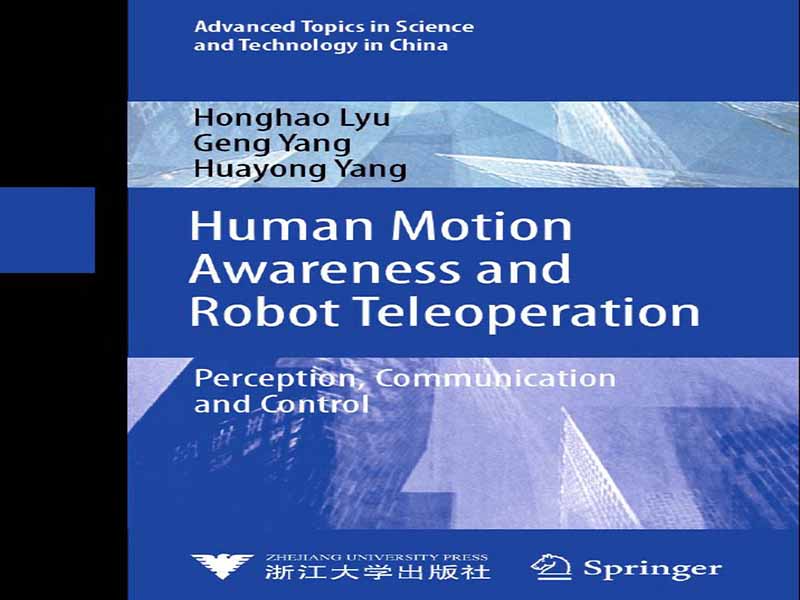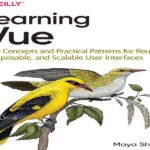- عنوان کتاب: Human Motion Awareness and Robot Teleoperation -Perception, Communication and Control
- نویسنده: Honghao Lyu · Geng Yang · Huayong Yang
- حوزه: کنترل رباتیک
- سال انتشار: 2025
- تعداد صفحه: 155
- زبان اصلی: انگلیسی
- نوع فایل: pdf
- حجم فایل: 5.89 مگابایت
تلهاپریشن یک فناوری انسان در حلقه برای کنترل رباتها از راه دور است. اپراتورهای انسانی مسئول برنامهریزی سطح بالا و تصمیمگیری شناختی هستند، در حالی که ربات مسئول دستکاری است. این امر به انسانها اجازه میدهد تا ربات را از راه دور و بدون نیاز به حضور فیزیکی در محل کنترل کنند. با این حال، برای اپراتورهای انسانی غیرمتخصص مانند کارکنان مراقبتهای بهداشتی دشوار است که در مدت زمان کوتاهی با استفاده از روشهای سنتی تلهاپریشن، مهارتهای کنترل یک ربات تلهاپریشن را به دست آورند. با توسعه فناوریهای ضبط حرکت و تعامل انسان و ربات، تلهاپریشن مبتنی بر حرکت انسان به یک تمرکز تحقیقاتی در این زمینه تبدیل شده است. با این حال، مکانیسمهای استراتژیهای نقشهبرداری حرکت انسان و ربات نامشخص است و منجر به مشکلاتی در کنترل حرکت دو بازو و کنترل حرکت تمام بدن رباتها با درجه تحریک بالا میشود. علاوه بر این، تأخیر شبکه و عدم قطعیت ارتباط در حلقه کنترل بر عملکرد کنترل سیستمهای تلهاپریشن تأثیر میگذارد. برای پرداختن به این مسائل، تحقیقات این کتاب بر روی چهار جنبه کار میکند: نقشهبرداری حرکت تک بازو، نقشهبرداری حرکت دو بازو، نقشهبرداری حرکت تمام بدن و ارتباط قابل اعتماد برای تلهاپریشن. علاوه بر این، دو مورد کاربردی برای اعتبارسنجی قابلیت استفاده از استراتژیهای نقشهبرداری حرکت انسان از منظر مراقبت از راه دور در منزل و کمکهای پزشکی از راه دور در مراقبتهای بهداشتی ۴.۰ انجام شده است. یافتههای اصلی تحقیق به شرح زیر خلاصه شدهاند: (1) یک چارچوب نقشهبرداری مبتنی بر حرکت انسان برای عملیات از راه دور تک بازو پیشنهاد شده است. این چارچوب از حرکات اندام فوقانی اپراتور به عنوان ورودی برای کنترل عملگر نهایی بازوی رباتیک استفاده میکند. یک روش نقشهبرداری محدود به مسیر برای بهبود عملکرد ردیابی مسیر حرکت ربات در طول فرآیند عملیات از راه دور پیشنهاد شده است. بر اساس این روش، انحراف ردیابی موقعیت بین مسیر اپراتور و ربات در فرکانس نمونهبرداری ۷.۵ هرتز برای مسیرهای حرکتی ساده ۱.۰۵ میلیمتر است، در حالی که انحراف ردیابی موقعیت برای مسیرهای پیچیده ۵.۱۰ میلیمتر است. (2) یک استراتژی نقشهبرداری حرکت افزایشی برای حذف فرآیند اولیهسازی و کالیبراسیون دست و پا گیر که معمولاً در سایر سیستمهای نقشهبرداری حرکت از راه دور مورد نیاز است، پیشنهاد شده است. این استراتژی امکان تنظیمات انعطافپذیر وضعیت اندام اپراتور را فراهم میکند و راحتی و شهودی بودن عملیات از راه دور را بهبود میبخشد. علاوه بر این، یک تکنیک نگاشت ترکیبی از حرکت دست و حرکت اندام فوقانی (GuLiM) به عنوان یک رویکرد جدید در نگاشت حرکت انسان-ربات دو بازو ارائه شده است. آزمایشهای مقایسهای نشان داد که روش GuLiM در دقت قرارگیری برای انتقال موقعیت و انتقال جهت، با بهبود دقت به ترتیب 46.77٪ و 69.27٪، از روش نگاشت مستقیم (DMM) پیشی گرفته است. (3) یک روش تشخیص مسیر حرکت دست با استفاده از استخراج ویژگی پسزمینه و تحلیل سرعت پیشنهاد شده است. 10 نوع دستور حرکتی برای کنترل حرکت ربات طراحی شده است. الگوریتم تشخیص در اعتبارسنجی متقابل به دقت تشخیص 97.34٪ میرسد. علاوه بر این، یک استراتژی تلهاکشن نگاشت حرکت تنه بر اساس حرکت ستون فقرات بالاتنه و حرکت اندام تحتانی اپراتور معرفی شده است که کنترل شهودی تنه ربات را با درجات آزادی اضافی محقق میکند. دو مورد کاربردی مراقبت از سالمندان و کمک پزشکی در Healthcare 4.0 برای تأیید تلهاکشن مبتنی بر حرکت انسان پیشنهادی به ترتیب در محیط داخلی و بخش ایزوله بیمارستان انجام شده است. (4) یک چارچوب شبیهسازی سختافزار در حلقه شبکه برای ارزیابی تأثیرات عملکرد شبکه بر کنترل از راه دور ربات توسعه داده شده است. تعامل بین ارتباط و کنترل تحت شرایطی مانند اتصالات شبکه محلی 5G و Wi-Fi 6 بررسی شده است و یک قانون انتخاب برای انتخاب شبکههای بیسیم در مناطق محلی با پروفایلهای مختلف ارائه شده است. علاوه بر این، یک چارچوب عملیات از راه دور مبتنی بر ابر بر روی اتصالات شبکه گسترده با مسافت بسیار طولانی معرفی شده است. یک کنترلکننده پیشخور جدید برای کاهش خطاهای ردیابی بین اپراتور و ربات طراحی شده است. این رویکرد با موفقیت عملیات از راه دور مبتنی بر حرکت انسان بین قارهای را در بیش از 7800 کیلومتر، از سوئد تا چین، امکانپذیر کرده است.
Teleoperation is a human-in-the-loop technology for controlling robots remotely. The human operators are responsible for high-level planning and cognitive decisionmaking, while the robot is responsible for manipulation. This allows humans to control the robot remotely without having to be physically present on-site. However, it is difficult for non-expert human operators like healthcare workers to master the control skills of a teleoperated robot in a short time using traditional teleoperation methods. With the development of motion capture and human-robot interaction technologies, human-motion-based teleoperation has become a research focus in the field. However, the mechanisms of human-robot motion mapping strategies are unclear, leading to difficulties in dual-arm motion control and full-body motion control of the robots with high degree-of-actuation. Additionally, the network latency and uncertainty of the communication within the control loop affect the control performance of teleoperation systems. To address these issues, the research of the book works on four aspects: single-arm motion mapping, dual-arm motion mapping, full-body motion mapping, and reliable communication for teleoperation. Moreover, two application cases are conducted to validate the usability of the human motion mapping strategies from the perspective of remote home care and remote medical assistance in Healthcare 4.0. The main research findings are summarized as follows: (1) A human-motion-based mapping framework for single-arm teleoperation is proposed. The framework uses the operator’s upper limb movements as input to control the end effector of the robotic arm. A path-constrained mapping method is proposed to improve the motion trajectory tracking performance of the robot during the teleoperation process. Based on this method, the position tracking deviation between the trajectory of the operator and robot is 1.05 mm at the sampling frequency of 7.5 Hz for simple motion trajectories, while the position tracking deviation is 5.10 mm for complex trajectories. (2) An incremental motion mapping strategy is proposed to eliminate the cumbersome initialization and calibration process typically required in other motion mapping teleoperation systems. It allows flexible adjustments of the operator’s limb posture, improving the convenience and intuitiveness of the teleoperation. Furthermore, a hybrid mapping technique of hand gesture and upper-limb motion (GuLiM) is presented as a novel approach in dual-arm human-robot motion mapping. Comparative experiments showed that the GuLiM method surpassed the Directly Mapping Method (DMM) at the placement precision for position transfer and orientation transfer, with an improvement in accuracy of 46.77% and 69.27%, respectively. (3) A hand gesture trajectory recognition method is proposed using background feature extraction and speed analysis. 10 types of gesture commands are designed for controlling robot locomotion. The recognition algorithm reaches 97.34% recognition accuracy in cross-validation. Further, a trunk motion mapping teleoperation strategy is introduced based on the upper body spine motion and lower limb motion of the operator, achieving intuitive control of the robot trunk with redundant degrees of freedom. Two application cases of elderly care and medical assistance in Healthcare 4.0 are conducted to verify the proposed human-motion-based teleoperation in the indoor environment and hospital isolation ward, respectively. (4) A network hardware-in-the-loop simulation framework is developed to evaluate the impacts of the network performance on remote robot control. The interplay between communication and control is investigated under conditions such as 5G and Wi-Fi 6 local network connections, and a selection rule is given for choosing the wireless networks in local areas with different profiles. Moreover, a cloud-based teleoperation framework is introduced over ultra-long-distance wide-area network connections. A novel feedforward controller is designed to reduce tracking errors between the operator and the robot. This approach has successfully enabled intercontinental human-motion-based teleoperation over 7800 km, from Sweden to China.
این کتاب را میتوانید از لینک زیر بصورت رایگان دانلود کنید:




































نظرات کاربران